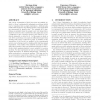Free Online Productivity Tools
i2Speak
i2Symbol
i2OCR
iTex2Img
iWeb2Print
iWeb2Shot
i2Type
iPdf2Split
iPdf2Merge
i2Bopomofo
i2Arabic
i2Style
i2Image
i2PDF
iLatex2Rtf
Sci2ools
GECCO
2007
Springer
2007
Springer
ACOhg: dealing with huge graphs
Ant Colony Optimization (ACO) has been successfully applied to those combinatorial optimization problems which can be translated into a graph exploration. Artificial ants build solutions step by step adding solution components that are represented by graph nodes. The existing ACO algorithms are suitable when the graph is not very large (thousands of nodes) but is not useful when the graph size can be a challenge for the computer memory and cannot be completely generated or stored in it. In this paper we study a new ACO model that overcomes the difficulties found when working with a huge construction graph. In addition to the description of the model, we analyze in the experimental section one technique used for dealing with this huge graph exploration. The results of the analysis can help to understand the meaning of the new parameters introduced and to decide which parameterization is more suitable for a given problem. For the experiments we use one real problem with capital importa...
| Added | 07 Jun 2010 |
| Updated | 07 Jun 2010 |
| Type | Conference |
| Year | 2007 |
| Where | GECCO |
| Authors | Enrique Alba, J. Francisco Chicano |
Comments (0)

